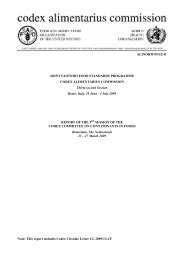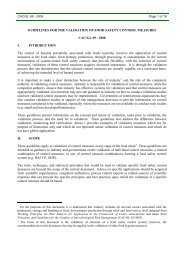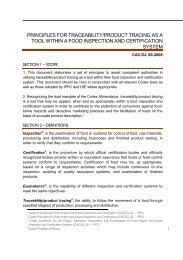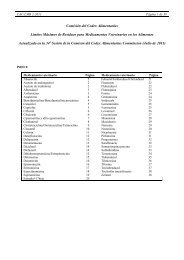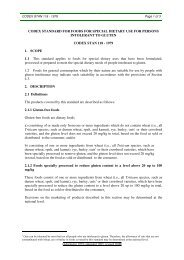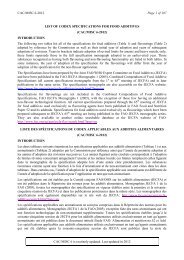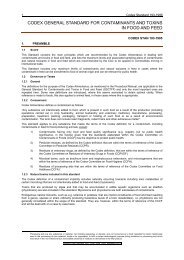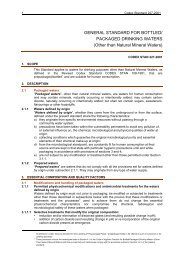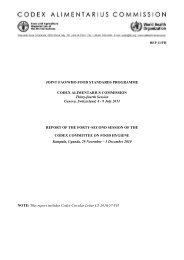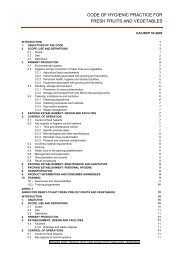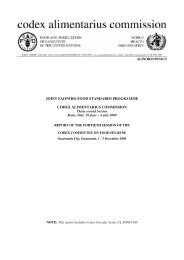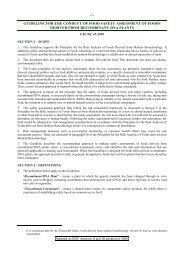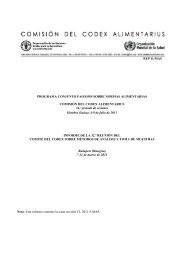General Standard for Food Additives - CODEX Alimentarius
General Standard for Food Additives - CODEX Alimentarius
General Standard for Food Additives - CODEX Alimentarius
You also want an ePaper? Increase the reach of your titles
YUMPU automatically turns print PDFs into web optimized ePapers that Google loves.
<strong>CODEX</strong> STAN 192-1995 Page 23 of 287<br />
02.2 Fat emulsions mainly of type water-in-oil:<br />
Include all emulsified products excluding fat-based counterparts of dairy products and dairy desserts.<br />
02.2.1 Butter:<br />
Butter is a fatty product consisting of a primarily water-in-oil emulsion derived exclusively from milk and/or<br />
36<br />
products obtained from milk.<br />
02.2.2 Fat spreads, dairy fat spreads and blended spreads:<br />
Includes fat spreads (emulsions principally of the type water and edible fats and oils), dairy fat spreads<br />
(emulsions principally of the type water-in-milkfat), and blended spreads (fat spreads blended with higher<br />
37<br />
amounts of milkfat). Examples include margarine (a spreadable or fluid water-in-oil emulsion produced<br />
mainly from edible fats and oils); products derived from butter (e.g., “butterine,” a spreadable butter blend<br />
with vegetable oils) 38 blends of butter and margarine; and minarine (a spreadable water-in-oil emulsion<br />
produced principally from water and edible fats and oils that are not solely derived from milk). Also includes<br />
reduced fat-based products derived from milkfat or from animal or vegetable fats, including reduced-fat<br />
counterparts of butter, margarine, and their mixtures (e.g., three-quarter fat butter, three-quarter fat<br />
margarine, or three-quarter fat butter-margarine blends).<br />
02.3 Fat emulsions mainly of type oil-in-water, including mixed and/or flavoured products based on fat<br />
emulsions:<br />
Includes fat-based counterparts of dairy-based foods excluding dessert products. The fat portion of these<br />
products are derived from sources other than milkfat (e.g., vegetable fats and oils). Examples include:<br />
imitation milk (a fat-substituted milk produced from non-fat milk solids by addition of vegetable fats<br />
14<br />
(coconut, safflower or corn oil)); non-dairy whipped cream; non-dairy toppings; and vegetable cream.<br />
Mayonnaise is included in food category 12.6.1.<br />
02.4 Fat-based desserts excluding dairy-based dessert products of food category 01.7:<br />
Includes fat-based counterparts of dairy-based desserts, which are found in category 01.7. Includes ready-toeat<br />
products and their mixes. Also includes non-dairy fillings <strong>for</strong> desserts. An example is an ice cream-like<br />
product made with vegetable fats.<br />
03.0 Edible ices, including sherbet and sorbet:<br />
This category includes water-based frozen desserts, confections and novelties, such as fruit sorbet, “Italian”style<br />
ice, and flavoured ice. Frozen desserts containing primarily dairy ingredients are included in food<br />
category 01.7.<br />
04.0 Fruits and vegetables (including mushrooms and fungi, roots and tubers, pulses and legumes, and aloe<br />
vera), seaweeds, and nuts and seeds:<br />
This major category is divided into two categories: 04.1(Fruit) and 04.2 (Vegetables (including mushrooms<br />
and fungi, roots and tubers, pulses and legumes, and aloe vera), seaweeds, and nuts and seeds). Each of these<br />
categories is further divided into sub-categories <strong>for</strong> fresh and processed products.<br />
04.1 Fruit:<br />
Includes all fresh (04.1.1) and processed (04.1.2) products.<br />
04.1.1 Fresh fruit:<br />
Fresh fruit is generally free of additives. However, fresh fruit that is coated or cut or peeled <strong>for</strong> presentation<br />
to the consumer may contain additives.<br />
04.1.1.1 Untreated fresh fruit:<br />
Raw fruit presented fresh from harvest.<br />
36<br />
Codex <strong>Standard</strong> <strong>for</strong> Butter (<strong>CODEX</strong> STAN 279-1971).<br />
37<br />
Codex <strong>Standard</strong> <strong>for</strong> Dairy Fat Spreads (<strong>CODEX</strong> STAN 253-2006); and Codex <strong>Standard</strong> <strong>for</strong> Fat Spreads and<br />
Blended Spreads (<strong>CODEX</strong> STAN 256-2007).<br />
38<br />
<strong>Food</strong> Chemistry, H.-D. Belitz & W. Grosch, Springer-Verlag, Heidelberg, 1987, p. 395.



